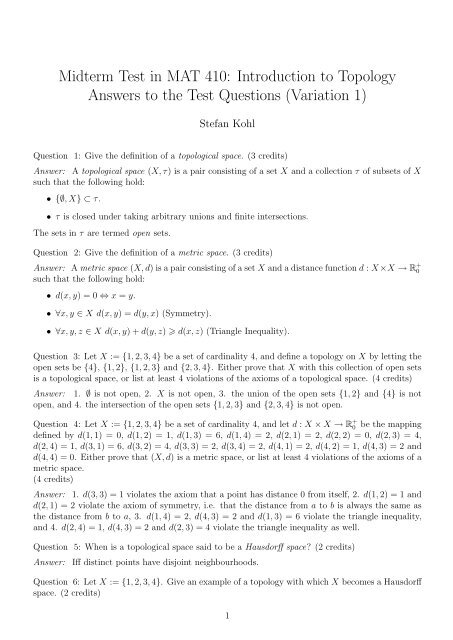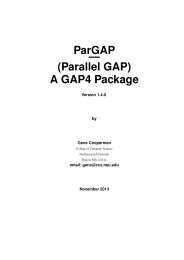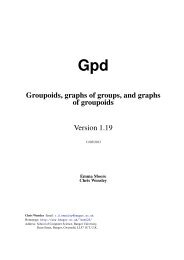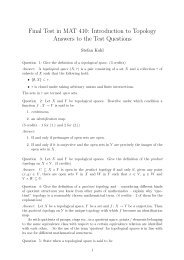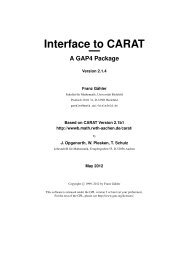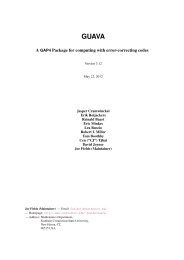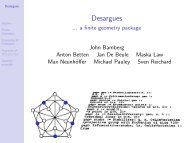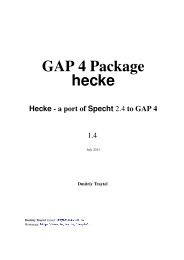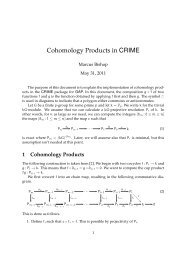Midterm Test in MAT 410: Introduction to Topology Answers to ... - Gap
Midterm Test in MAT 410: Introduction to Topology Answers to ... - Gap
Midterm Test in MAT 410: Introduction to Topology Answers to ... - Gap
You also want an ePaper? Increase the reach of your titles
YUMPU automatically turns print PDFs into web optimized ePapers that Google loves.
<strong>Midterm</strong> <strong>Test</strong> <strong>in</strong> <strong>MAT</strong> <strong>410</strong>: <strong>Introduction</strong> <strong>to</strong> <strong>Topology</strong><br />
<strong>Answers</strong> <strong>to</strong> the <strong>Test</strong> Questions (Variation 1)<br />
Stefan Kohl<br />
Question 1: Give the def<strong>in</strong>ition of a <strong>to</strong>pological space. (3 credits)<br />
Answer: A <strong>to</strong>pological space (X, τ) is a pair consist<strong>in</strong>g of a set X and a collection τ of subsets of X<br />
such that the follow<strong>in</strong>g hold:<br />
• {∅, X} ⊂ τ.<br />
• τ is closed under tak<strong>in</strong>g arbitrary unions and f<strong>in</strong>ite <strong>in</strong>tersections.<br />
The sets <strong>in</strong> τ are termed open sets.<br />
Question 2: Give the def<strong>in</strong>ition of a metric space. (3 credits)<br />
Answer: A metric space (X, d) is a pair consist<strong>in</strong>g of a set X and a distance function d : X ×X → R + 0<br />
such that the follow<strong>in</strong>g hold:<br />
• d(x, y) = 0 ⇔ x = y.<br />
• ∀x, y ∈ X d(x, y) = d(y, x) (Symmetry).<br />
• ∀x, y, z ∈ X d(x, y) + d(y, z) d(x, z) (Triangle Inequality).<br />
Question 3: Let X := {1, 2, 3, 4} be a set of card<strong>in</strong>ality 4, and def<strong>in</strong>e a <strong>to</strong>pology on X by lett<strong>in</strong>g the<br />
open sets be {4}, {1, 2}, {1, 2, 3} and {2, 3, 4}. Either prove that X with this collection of open sets<br />
is a <strong>to</strong>pological space, or list at least 4 violations of the axioms of a <strong>to</strong>pological space. (4 credits)<br />
Answer: 1. ∅ is not open, 2. X is not open, 3. the union of the open sets {1, 2} and {4} is not<br />
open, and 4. the <strong>in</strong>tersection of the open sets {1, 2, 3} and {2, 3, 4} is not open.<br />
Question 4: Let X := {1, 2, 3, 4} be a set of card<strong>in</strong>ality 4, and let d : X × X → R + 0 be the mapp<strong>in</strong>g<br />
def<strong>in</strong>ed by d(1, 1) = 0, d(1, 2) = 1, d(1, 3) = 6, d(1, 4) = 2, d(2, 1) = 2, d(2, 2) = 0, d(2, 3) = 4,<br />
d(2, 4) = 1, d(3, 1) = 6, d(3, 2) = 4, d(3, 3) = 2, d(3, 4) = 2, d(4, 1) = 2, d(4, 2) = 1, d(4, 3) = 2 and<br />
d(4, 4) = 0. Either prove that (X, d) is a metric space, or list at least 4 violations of the axioms of a<br />
metric space.<br />
(4 credits)<br />
Answer: 1. d(3, 3) = 1 violates the axiom that a po<strong>in</strong>t has distance 0 from itself, 2. d(1, 2) = 1 and<br />
d(2, 1) = 2 violate the axiom of symmetry, i.e. that the distance from a <strong>to</strong> b is always the same as<br />
the distance from b <strong>to</strong> a, 3. d(1, 4) = 2, d(4, 3) = 2 and d(1, 3) = 6 violate the triangle <strong>in</strong>equality,<br />
and 4. d(2, 4) = 1, d(4, 3) = 2 and d(2, 3) = 4 violate the triangle <strong>in</strong>equality as well.<br />
Question 5: When is a <strong>to</strong>pological space said <strong>to</strong> be a Hausdorff space? (2 credits)<br />
Answer:<br />
Iff dist<strong>in</strong>ct po<strong>in</strong>ts have disjo<strong>in</strong>t neighbourhoods.<br />
Question 6: Let X := {1, 2, 3, 4}. Give an example of a <strong>to</strong>pology with which X becomes a Hausdorff<br />
space. (2 credits)<br />
1
Answer:<br />
The discrete <strong>to</strong>pology.<br />
Question 7: Let X 1 := {1, 2, 3} and X 2 := {4, 5, 6} be <strong>to</strong>pological spaces, where the open sets <strong>in</strong> X 1<br />
are ∅, {1, 2}, {3} and X 1 , and the open sets <strong>in</strong> X 2 are ∅, {4, 6}, {5} and X 2 . Give an example of a<br />
homeomorphism from X 1 <strong>to</strong> X 2 . (2 credits)<br />
Answer: ϕ : X 1 → X 2 , 1 ↦→ 4, 2 ↦→ 6, 3 ↦→ 5.<br />
Question 8: When is a metric space X said <strong>to</strong> be complete? (2 credits)<br />
Answer: Iff every Cauchy sequence of po<strong>in</strong>ts of X converges <strong>to</strong> a po<strong>in</strong>t of X.<br />
Question 9: Is a <strong>to</strong>pological space always also a metric space? (2 credits)<br />
Answer:<br />
No.<br />
Question 10: Give an example of a <strong>to</strong>pological space <strong>in</strong> which the union of <strong>in</strong>f<strong>in</strong>itely many closed<br />
sets is not always closed. (2 credits)<br />
Answer:<br />
R with the usual <strong>to</strong>pology.<br />
Question 11: The Can<strong>to</strong>r set is the subset of the unit <strong>in</strong>terval [0, 1] conta<strong>in</strong><strong>in</strong>g precisely those<br />
numbers which have a ternary numeral <strong>in</strong>volv<strong>in</strong>g only digits 0 and 2. (Ternary digits are digits with<br />
respect <strong>to</strong> base 3, just like decimal digits are digits with respect <strong>to</strong> base 10). Determ<strong>in</strong>e the closure<br />
and the <strong>in</strong>terior of the Can<strong>to</strong>r set <strong>in</strong> the usual <strong>to</strong>pology on R. (2 credits)<br />
Answer: The Can<strong>to</strong>r set is closed, s<strong>in</strong>ce it is the complement of a union of open <strong>in</strong>tervals. So the<br />
closure is the Can<strong>to</strong>r set itself. The Can<strong>to</strong>r set is nowhere dense, s<strong>in</strong>ce between any two of its po<strong>in</strong>ts<br />
there are <strong>in</strong>tervals conta<strong>in</strong><strong>in</strong>g only real numbers hav<strong>in</strong>g also 1’s as ternary digits. So the <strong>in</strong>terior of<br />
the Can<strong>to</strong>r set is ∅.<br />
Question 12: Which problem occurs when try<strong>in</strong>g <strong>to</strong> embed the Kle<strong>in</strong> bottle <strong>in</strong><strong>to</strong> R 3 ? (2 credits)<br />
Answer: The problem that it is not possible <strong>to</strong> embed the Kle<strong>in</strong> bottle <strong>in</strong><strong>to</strong> R 3 without allow<strong>in</strong>g<br />
self-<strong>in</strong>tersection.<br />
2


